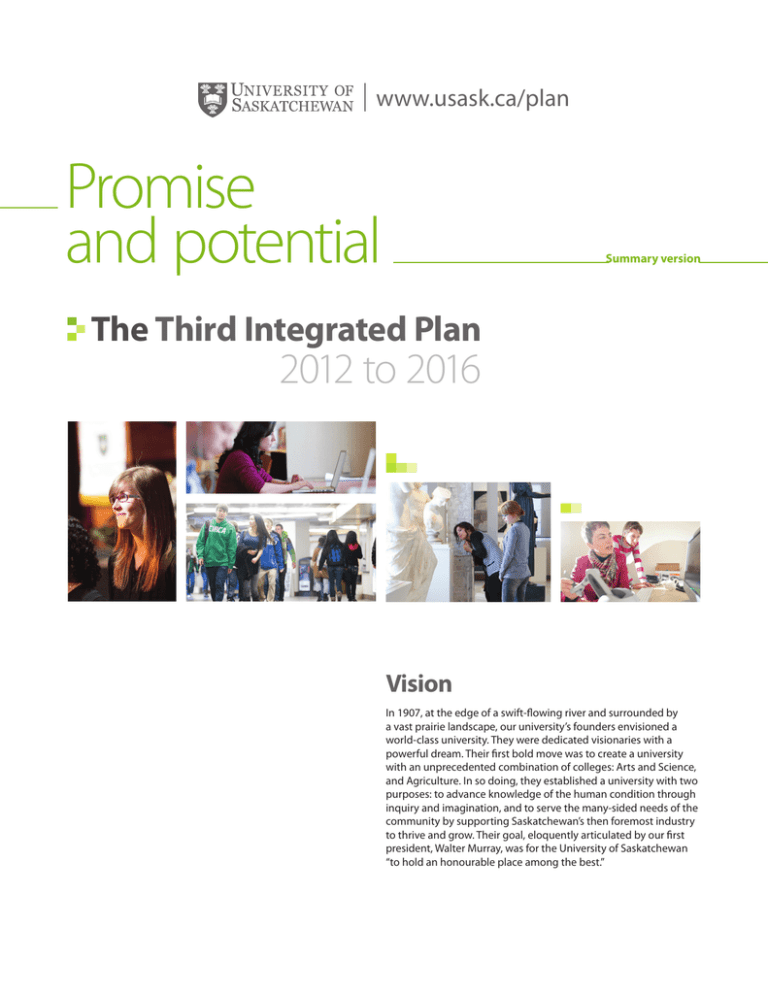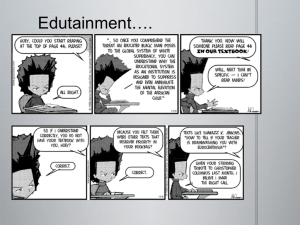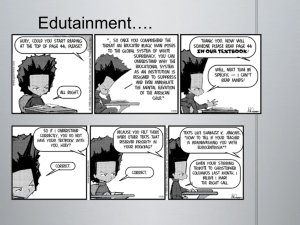Promise and potential 2012 to 2016 The
advertisement

www.usask.ca/plan Promise and potential Summary version The Third Integrated Plan 2012 to 2016 Vision In 1907, at the edge of a swift-flowing river and surrounded by a vast prairie landscape, our university’s founders envisioned a world-class university. They were dedicated visionaries with a powerful dream. Their first bold move was to create a university with an unprecedented combination of colleges: Arts and Science, and Agriculture. In so doing, they established a university with two purposes: to advance knowledge of the human condition through inquiry and imagination, and to serve the many-sided needs of the community by supporting Saskatchewan’s then foremost industry to thrive and grow. Their goal, eloquently articulated by our first president, Walter Murray, was for the University of Saskatchewan “to hold an honourable place among the best.” Knowledge Creation: Innovation and Impact We will establish a pervasive culture of research and scholarship throughout the institution. By implementing a comprehensive suite of research initiatives at the institutional and college levels encompassing the key functions of recruiting, supporting and networking existing and new researchers, and strengthening strategic focus, we will round out research engagement throughout the institution and ramp up outcomes and impacts generally as well as specifically within selective areas aligned with the six signature areas of research. Commitments: Recruit the Best Support Faculty and Graduate Students to Succeed Strengthen Strategic Focus Our success in achieving our goals will be measured against activities that contribute to making research and knowledge transfer more significant and meaningful. We will know we are on track if, by 2016, we have: Increased our performance in Tri-Agency funding in each academic unit against our peers, on track toward above-average ranking in all units and all competitions by 2020. Increased the proportion of research-appointed faculty holding Tri-Agency funding and/or supervising graduate students in all departments, colleges and schools. Increased the number, citations and impact of faculty publications tracking toward national and disciplinary comparators and improved placement for the university in major national and international ranking systems. Established new targeted institutes and hired the faculty and staff required to move them forward. Established a fully subscribed and effective mentorship program for new and early-career faculty. Increased externally funded trusts to support a more comprehensive array of funding supports for graduate students approaching the national average at medical-doctoral peer universities, e.g., teaching assistantships. Increased internally funded graduate scholarships by a further $1M and increased by 10 per cent the number of Tri-Agency-funded graduate and undergraduate students. Increased enrolments in PhD programs by 10 per cent to support our more intensive research culture. Established a baseline and increased by 50 per cent the number of undergraduate students participating in research. Innovation in Academic Programs and Services We will implement a strategic approach to enrolment by creating a mix of programs and learners that reflect deliberately chosen academic priorities, builds synergies with our signature areas of research, facilitates student movement between degree programs and mobility between institutions, addresses low enrolment programs, and supports college and school goals to rethink programs profoundly. Commitments: Actively Shape our Student Body Focus on Learner-Centred Programming and Curricular Innovation Foster Student Creativity and Innovation Demonstrate Effectiveness Our success in achieving our goals will be measured against activities that contribute to making our programs and services more effective and streamlined. We will know we are on track if, by 2016, we have: Defined learning outcomes for all undergraduate and graduate programs. Established a baseline and increased by 20 per cent the number of students engaging in experiential learning, including community-service learning, internships, undergraduate research, international student exchanges and co-op experiences within their academic programs. Achieved the goal of institutional graduate enrolment at 20 per cent of total enrolment. Obtained improved student satisfaction ratings associated with student advising on national and international surveys. Increased the number of external transfer students by 10 per cent. Established a baseline and increased by 10 per cent the number of students and faculty engaged in international research and development work and in study-abroad programs. Benchmarked the administrative efficiency of administrative/academic support units against comparators. Obtained improved student ratings on their learning environment through improvements in National Survey of Student Engagement (NSSE) scores. Implemented the recommendations of a joint Council-Provost Task Force on student financial aid. 2 | University of Saskatchewan | Third Integrated Plan 2012 to 2016 Aboriginal Engagement: Relationships, Scholarship, Programs We will be characterized as a place with diversified approaches and flourishing initiatives in every college and school involving rigorous and supportive programs for Aboriginal student success, engagement with Aboriginal communities, inclusion of Indigenous knowledge and experience in curricular offerings and intercultural engagement among faculty, staff and students. Commitments: Co-ordinate and Strengthen University-Community Relationships Celebrate Success and Leverage Internal Expertise Increase Visibility of Aboriginal Culture and Symbols on Campus Our success in achieving our goals will be measured against activities that contribute to making Aboriginal engagement at all levels more significant and more meaningful. We will know we are on track if, by 2016, we have: Increased the institutional first to second year direct-entry retention rate of Aboriginal students by 10 per cent, on track to achieving the goal of Aboriginal enrolment at 15 per cent of total enrolment by 2020. Increased the graduation rates of self-identified Aboriginal students in a wider array of programs. Implemented a registry and/or portal documenting Aboriginal initiatives, programs, services and partnerships. Increased the visibility of Aboriginal culture, language and symbols throughout the campus, beginning with the Gordon Oakes-Red Bear Student Centre and including institutional, college, school and unit websites, on roadways and signage, and on and within buildings. Established a set of prestigious awards for faculty and students to recognize scholarship, accomplishment, innovations in pedagogy and contributions to reconciliation and understanding between Aboriginal peoples and newcomers in Canada. Established initiatives and programs that encourage and enable faculty experts and Aboriginal students to engage with counterparts in other regions of the world. Established a baseline for courses providing undergraduate students with experiential learning through outreach and engagement involving Aboriginal communities or organizations. Established a baseline for research partnerships or projects happening in and with Aboriginal communities. Culture and Community: Our Local and Global Sense of Place We will model innovation through creative responses to challenging environmental, social and economic problems. To do so will mean that we are open to possibility, take chances on new ventures and on innovative ideas, and expect a mixture of success and failure as a rite of passage. Commitments: Celebrate and Promote Diversity/Inclusiveness Model Sustainability and Practise Effective Stewardship of Institutional Resources Our success in achieving our goals will be measured against activities that contribute to making culture and community more significant and meaningful. We will know we are on track if, by 2016, we have: Engaged a significant proportion of faculty, staff and students in activities designed to increase intercultural awareness and understanding and improve intercultural competencies. Increased the number of self-identified Aboriginal employees from the current 2.6 to 4 per cent. Implemented a Campus Climate Survey to assess the level of welcome our campus environment provides to its increasingly diverse population. Set 2020 targets for diversity among the student and employee populations. Set 2020 targets for retention and graduation rates for provincial, international and out-of-province undergraduate and graduate students. Demonstrated an increase of our sustainability activities, on target toward a Sustainability Tracking, Assessment and Rating System (STARS) rating of silver by 2020. www.usask.ca/plan | Promise and potential | 3 Resources to support this plan This Third Integrated Plan for the University of Saskatchewan is supported by a Multi-Year Budget Framework, a MultiYear Capital Plan, planning parameters for colleges, schools, and units, and an implementation plan that are in the final stages of development. Together, these documents comprise the university-level plan, financial and capital resources and implementation strategy for the next four years. Contacts Provost and Vice-President Academic University of Saskatchewan 204 College Building Saskatoon, SK S7N 5A2 Canada Phone: (306) 966-8489 Fax: (306) 975-1026 www.usask.ca/vpacademic Assistant Provost, Institutional Planning and Assessment University of Saskatchewan 105 Administration Place Saskatoon, SK S7N 5A2 Canada Phone: (306) 966-2489 Fax: (306) 975-1026 www.usask.ca/ipa Conclusion A plan establishes priorities in the context of a moment in time, an internal and external environment, and available information. The best planning takes into account vision, capacity and strengths. This plan builds on a foundation of strategic thinking and implementation that makes it adaptive to changing circumstances while being anchored to shared vision and goals. Our campus is a different place than it was a decade ago; this is a product not only of changing times but of concerted effort, collegial processes and, importantly, the determined environment that we have collectively created and fostered. As with our previous two plans, the success of this plan and the objectives of the university depend on the engagement of our faculty, post-doctoral fellows, sessional lecturers, undergraduate and graduate students, and staff. We have a collective responsibility for governance, administration and outcomes. Working together within the university and with our local, national and international partners provides us with the platform for success. We are building on a track record of success. We are confident that we will realize, in this planning cycle, the full promise and potential of our hard work and choices. As we work together, we move ever closer toward our goal of "an honourable place among the best."





